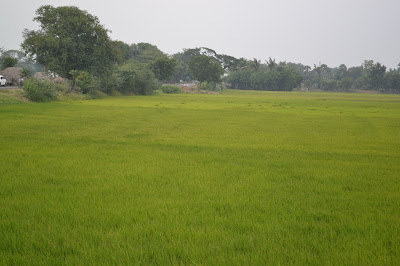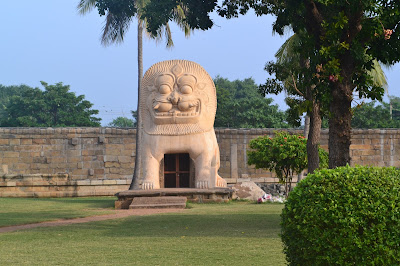Like i said in my previous post after coming back from the lignite mines, the elders insisted we should give up on Tranquebar. They felt we were tired to take on the journey and as it is we had to drive next day afternoon to Chennai. My husband whose passion other than high way driving is sleeping was only too eager to stall of the journey.
But thankfully, i could convince everybody but by then it was 2 in the afternoon. So after a refreshing mug of coffee /tea we left to Tranquebar at 3 in the noon.
The weather again was supportive, cool, breezy and even cloudy. We journeyed through Bhuvanagiri and a Saivaite temple town , Chidambaram( called Thillai in tamil).
Driving through Bhuvanagiri which is famous as the birthplace of the madhwa saint Sri Raghavendra swami cut me off from the colors of Rainbow except two. The Blue sky and the green paddy fields is all i saw when we drove through this beautiful plains. A sight i missed at Thanjavur i caught during my drive here. We enjoyed the country side plains of this agricultural town.
The above are moving shots. Did'nt i tell you, the weather was perfect driving weather considering it is coastal region, the weather was salubrious and not sultry.
This is a shot taken from the petrolbunk where we refilled fuel. All around i could only see green and sky blue.
And we bypassed the othe famous temple town which is a destination for many. Chidambaram, the temple town famous for the Thillai Nataraja temple. Here the main idol is the dancing Shiva and this form of shiva frozen in bronze is the icon of Indian culture and adorns many Indian homes. Two of the idols adorn a place of pride in my home too. This place hosts one of the world's unparalled classical Indian dance/ballet fest called 'Natyanjali' which draws classical Bharatanatyam dancers from farway countries like Aust, Maldives, Srilanka, UK, US amongst others. This fest generally happens in March and coincides with the Mahashivratri festival. It is on my wishlist to visit Chidambaram during the fest and soak the cultural atmosphere. Someday i will.
(pic courtesy: google)
But this time we traveled on the eve of another shaivaite tamil festival called Arudra Darisanam. Having visited this temple some 6 years back, we took the chidambaram bypass road to tranquebar. We could see the temple tower lit beautifully with the words 'Shiva Shiva' in tamil from the bypass road. If interested, more about the architecture legend and history of the temple read here.
From here it was just a few more minutes drive through typical kuccha roads towards tranquebar. Though this area is close to the coast there is no road laid out here parallel to coast or to extend the east coast road. Laying such roads may cost agriculural land. The drive through kuccha roads took us to a fork road where one indicator read Poompuhar 8kms and the other indicator read MARG Karaikal. MARG is the marine infrastructure company and promotor of the ONGC port city and hence enroute from Chidambaram you will see MARG indicators for Karaikal but you will never find even one Tranquebar indicator. We took the Karaikal route since we knew it fell on this route and drove amongst lively villages. Just a few kms to drive into King's street to experience a slice of bygone Dutch India.There was something in the air which spelt and smelt of sea and a great history. More on my next travel post.......
But thankfully, i could convince everybody but by then it was 2 in the afternoon. So after a refreshing mug of coffee /tea we left to Tranquebar at 3 in the noon.
The weather again was supportive, cool, breezy and even cloudy. We journeyed through Bhuvanagiri and a Saivaite temple town , Chidambaram( called Thillai in tamil).
Driving through Bhuvanagiri which is famous as the birthplace of the madhwa saint Sri Raghavendra swami cut me off from the colors of Rainbow except two. The Blue sky and the green paddy fields is all i saw when we drove through this beautiful plains. A sight i missed at Thanjavur i caught during my drive here. We enjoyed the country side plains of this agricultural town.
The above are moving shots. Did'nt i tell you, the weather was perfect driving weather considering it is coastal region, the weather was salubrious and not sultry.
This is a shot taken from the petrolbunk where we refilled fuel. All around i could only see green and sky blue.
(pic courtesy: google)
But this time we traveled on the eve of another shaivaite tamil festival called Arudra Darisanam. Having visited this temple some 6 years back, we took the chidambaram bypass road to tranquebar. We could see the temple tower lit beautifully with the words 'Shiva Shiva' in tamil from the bypass road. If interested, more about the architecture legend and history of the temple read here.
From here it was just a few more minutes drive through typical kuccha roads towards tranquebar. Though this area is close to the coast there is no road laid out here parallel to coast or to extend the east coast road. Laying such roads may cost agriculural land. The drive through kuccha roads took us to a fork road where one indicator read Poompuhar 8kms and the other indicator read MARG Karaikal. MARG is the marine infrastructure company and promotor of the ONGC port city and hence enroute from Chidambaram you will see MARG indicators for Karaikal but you will never find even one Tranquebar indicator. We took the Karaikal route since we knew it fell on this route and drove amongst lively villages. Just a few kms to drive into King's street to experience a slice of bygone Dutch India.There was something in the air which spelt and smelt of sea and a great history. More on my next travel post.......
The board says it all - the land of singing/dancing waves

















































